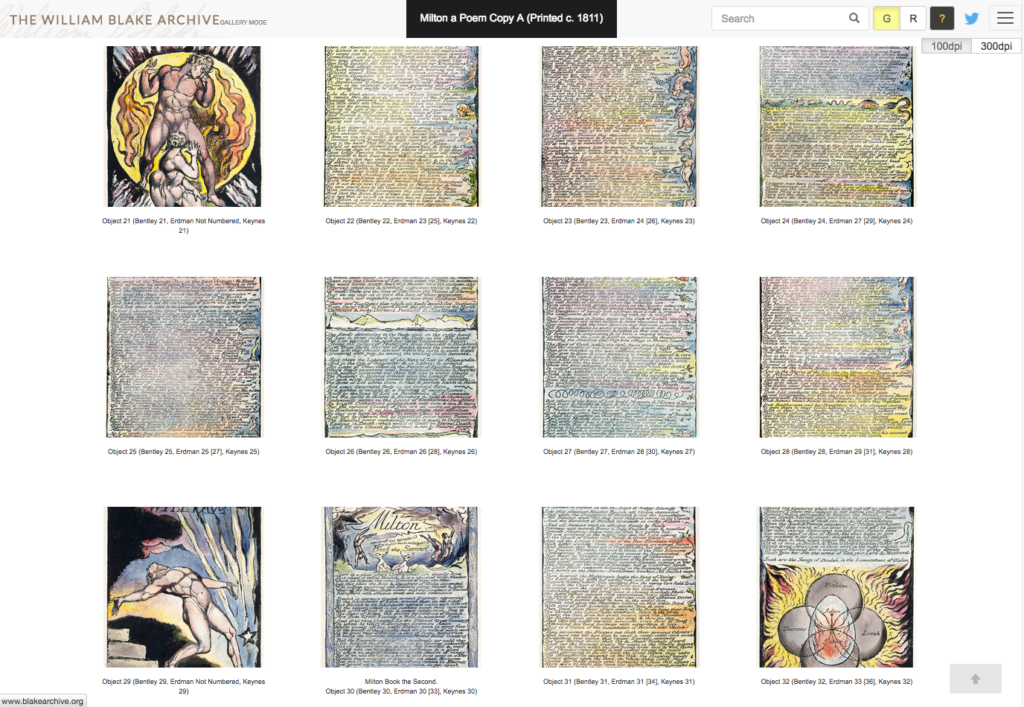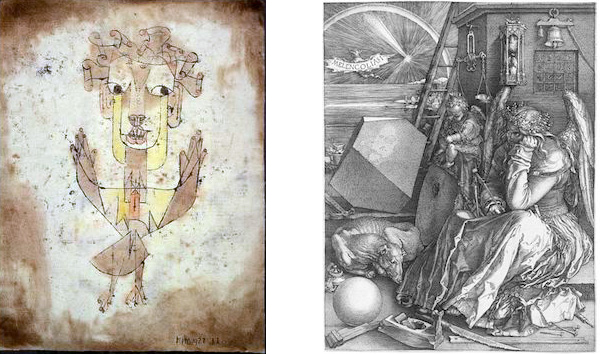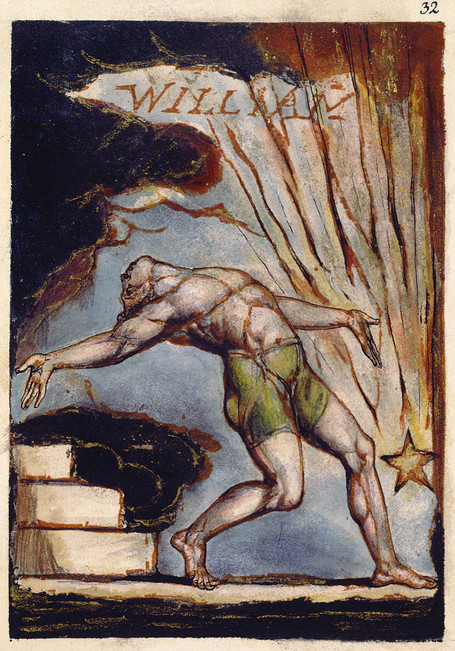William Blake explores crucial questions of time and historical transmission in the illustrations and text of his poem Milton, written at the turn of the nineteenth century (1804-1810). This work and a large number of Blake’s other original illuminated books, designs, engravings, and letters are now electronically available via The William Blake Archive (Fig. 1).

Fig. 1. Screenshot of pages from Blake’s “Milton: A Poem” (Copy A; c. 1811) on The William Blake Archive website, www.blakearchive.org.
As the reader clicks and browses, wandering through these traces of the artist’s corpus, one is almost inevitably drawn to ponder issues of transmediality and transmissibility. The archive and its contents evoke Jacques Derrida’s observation that material objects “move away from us at great speed, in a continually accelerated fashion” to “burrow into the past,” while at the same time pointing to the “unlimited upheaval under way in archival technology.”[1] For Derrida, this technology
no longer determines, will never have determined, merely the moment of the conservational recording, but rather the very institution of the archivable event. It conditions not only the form or the structure which prints, but the printed content of the printing: the pressure of the printing, the impression, before the division between the printed and the printer. This archival technique has commanded that which even in the past instituted and constituted whatever there was as anticipation of the future.
And as wager [gageure]. The archive has always been a pledge, and like every pledge [gage], a token of the future. To put it more trivially: what is no longer archived in the same way is no longer lived in the same way. Archivable meaning is also and in advance codetermined by the structure that archives. It begins with the printer.[2]
While new archival technologies are rapidly refashioning our ways of thinking about history and its diffusion, we might consider afresh how Blake, an artist and a poet who, incidentally, worked as a printer, experienced and grappled with artistic transmission. In this note I consider Blake’s original approach to this question in light of two works which came to embody twentieth-century thought on history and art: Paul Klee’s Angelus Novus (1920) and Albrecht Dürer’s Melancholia I (1514).

LEFT: Fig. 2. Paul Klee, Angelus Novus, 1920. Oil and watercolor on paper, 31.8 x 24.2 cm. The Israel Museum, Jerusalem. Image source: Wikimedia Commons.
RIGHT: Fig. 3. Albrecht Dürer, Melancholia I, 1514. Copperplate, 23.9 x 16.8 cm. Städel Museum, Frankfurt. Image source: Wikimedia Commons.
We know the twentieth century’s enthusiasm for angels as figures of history, and there is a sense that the angel who stood watch as the century came to a close crossed over into the new millennium. Klee’s Angelus Novus (Fig. 2), a canonical work of the twentieth century, was exhibited for the first time in France last year, as part of the artist’s retrospective at the Pompidou Centre (from April 6 to August 1 2016), Klee’s first in fifty years. This small watercolor owes its fame perhaps less to its creator than to its owner, Walter Benjamin, who purchased it in 1921. The painting came to inspire one of the central passages of Benjamin’s Theses on the Philosophy of History (1940), in which he identified the angelus with the angel of history:
His face is turned towards the past. Where we perceive a chain of events, he sees one single catastrophe which keeps piling wreckage upon wreckage and hurls it in front of his feet. The angel would like to stay, awaken the dead, and make whole what has been smashed. But a storm is blowing from Paradise; it has got caught in his wings with such violence that the angel can no longer close them. This storm irresistibly propels him into the future to which his back is turned, while the pile of debris before him grows skyward. This storm is what we call progress.[3]
Giorgio Agamben has suggested that if the Angelus Novus is the angel of history, one may read the sitting figure in Dürer’s Melancholia I as the angel of art (Fig. 3). If the angel of history looks to a past packed with no-longer intelligible ruins, while being forcefully propelled into the future, the angel engraved by Dürer is fully engrossed in the act of staring ahead, surrounded by an accumulation of objects that have lost their meaningful use. Here, the storm has subsided and the course of history is suspended in some kind of “messianic arrest,” where the past has solidified into an imposing obstacle.[4] Agamben therefore concludes that the two angels are inseparable. Together, they signal a state of crisis, a breach between past and future due to contemporary man’s inability to make use of an increasingly valuable yet paralyzing cultural heritage. Artistic objects have been invested with aesthetic value in their own right and have come to constitute a self-contained heritage separated from the act of transmission itself. The heritage may well fill in the breach, but it is also that which impedes the transmissibility of culture.[5]
We find a scheme that revises this play of push and pull with historical time in Hannah Arendt’s Between Past and Future (written in 1920, the same year Klee painted the Angelus Novus). Arendt quotes a parable by Kafka:
He has two antagonists: the first presses him from behind, from the origin. The second blocks the road ahead. He gives battle to both. To be sure, the first supports him in his fight with the second, for he wants to push him forward, and in the same way the second supports him in his fight with the first, since he drives him back.[6]
Arendt cuts through the conundrum of such conflicting “support” by focusing on what she refers to as the “diagonal force,” which results from the battlefield at the point where the two forces meet:
The diagonal force […] would be infinite with respect to its ending, by virtue of having resulted from the concerted action of two forces whose origin is infinity. This diagonal force, whose origin is known, whose direction is determined by past and future, but whose eventual end lies in infinity, is the perfect metaphor for the activity of thought.[7]
The tense fracture between past and future, according to Arendt, is the very place where thought can play out.

Fig. 4. William Blake, “Milton: A Poem” (Copy D, object 32), 1804-1811. Relief and white-line etching, hand colored, 16.0 x 11.2 cm. Library of Congress, Washington. © Image courtesy of The William Blake Archive, 2010, www.blakearchive.org.
In all four extant copies of Blake’s poem Milton, there is a relief etching where we find a visualization of this diagonal force (Fig. 4). An organic crosspoint between past and future, the image’s diagonal thrust emerges as an articulator of artistic transmission. Indeed the location of the plate within the text emphasizes its significance. The plate appears between the two books of the poem and acts as a bridge, visually and materially echoing a crucial moment that has already taken place at the narrative level: the poet Milton in the figure of a falling star, preparing to penetrate Blake’s left foot:
Then first I saw him in the Zenith as a falling star,
Descending perpendicular, swift as the swallow or swift;
And on my left foot falling on the tarsus, enter’d there;
But from my left foot, a black cloud redounding spread over Europe.[8]
The image arranges a field of diagonal forces, at once cosmic, spatial, and muscular. Blake’s body appears to have just descended a flight of stairs, which creates an acute angle in the lower left-hand corner of the illustration.[9] While the right-hand side of the body executes a backward movement, the left-hand side—running from the chin, down the sternum and the left leg to the toes—strikes out ahead. Specifically, it traces an oblique line, which parallels the slope drawn by the stairs behind, and the diagonal beams that converge in the star coming down along the left shin. Milton/the star is the dead poet, a presentification of the past. The text says that the star falls straight through William’s tarsus, which is identical to Britain-Albion’s left foot, as both the poet and personified Britain are located in the exact same point on the Sussex shore at the time of the event.[10] From hence, it shoots back up in the form of a Pan-European cloud, like the arc of a football hitting a player’s heel, thereby signaling the origin of yet another diagonal. From that moment, Blake’s foot becomes a channel for time past, present and future. Blake and Milton now operate as one force, before receiving reinforcement from Los—Blake’s mythical figure of the creator and of time itself—who significantly joins in by stooping to bind William’s sandals:
While Los heard indistinct in fear, what time I bound my sandals
On, to walk forward thro’ Eternity, Los descended to me:
And Los behind me stood: a terrible flaming Sun: just close
Behind my back; I turned round in terror and behold:
Los stood in that fierce glowing fire: and he also stooped down
And bound my sandals …[11]
A kiss later, Los and Blake have aligned forces (“he kissed me … / And I became One Man with him arising in my strength”).[12] We are dealing here with a force field polarized around Blake’s feet, which gestures toward multiple horizons and calls into question concepts of time and space, of the individual body, of artistic creation and transmission as linked to motricity. It is motor power that allows for the artist’s footstep and trace (ultimately shaped and transmitted as text and etchings) to come into action, and for the spatial and temporal bridge to take place when Blake, Milton and Los merge to embody the original site and vector of creation. Blake’s feet seem to generate the kind of print that Derrida describes as “an impression which is almost no longer an archive but which almost confuses itself with the pressure of the footstep which leaves its still-living mark on a substrate, a surface, a place of origin. When the step is still one with the subjectile.”[13]
Blake’s iconography signals that a novel way of thinking about historical models seems to be falling into place, literally channelled by the artist’s feet—the very site where a temporal skid and a particular form of transmission are about to be acted out. What time is it, and whose foot is this? may be a pertinent question at this stage. We gather that Milton, like Klee’s and Dürer’s works, points to an eschatological horizon in its own terms. Blake was a man of his time, and more. In Milton, he saw past the social and revolutionary ideals that enflamed his earlier poems (Songs of Experience, America, Europe, or The French Revolution). Contemporary life in the form of war, empire, exploitation, and technological progress stood in need of atonement, and Blake expanded into a mythology of his own invention so as to meet this necessity. His redemptive horizon, which does not coincide with the Judeo-Christian Apocalypse (although it does borrow some images of violence and regeneration, e.g. the vintage and the winepress), would eventually emerge as the creative work of Los:
This Wine-press is call’ed War on Earth, it is the Printing-press
Of Los; and here he lays his words in order above the mortal brain,
As cogs are formd in a Wheel to turn the cogs of the adverse wheel.[14]
Blake openly advocated social justice and the revision of the established order, and was tried in 1803 for seditious remarks about the King and the army, directed at a soldier he found relieving himself in his garden. While he was hardly a supporter of English nationalism, as the eighteenth century was drawing to a close, an “awakening of the most powerful industrial and military country in the world might easily be imagined as the apocalyptic event that would reunify the warring nations and shake humanity out of its crippling self-limitations.”[15] Blake’s writings are therefore political and eschatological, looking to move beyond extant (historical) systems by annihilating their structural logic and its constitutive elements:
The Wine-press on the Rhine groans loud but all its central beams
Act more terrific in the central Cities of the Nations,
Where Human Thought is crushed beneath the iron hand of Power.
There Los puts all into the Press, the Oppressor and the Oppressed…[16]
Room is thus made for a nude new world, one having cast off the covering of Newton’s and Locke’s “rational demonstrations” to be “clothed” and imprinted with poetic imagination instead.[17]
The artist at work is a cross-temporal agent of transmission endowed with exceptional stamina and the muscular tension required to keep the cogs going, so as to activate new prints, new models of thought. His “Anvils and his Furnaces rage: / Thundering the Hammers beat and the Bellows blow loud,”[18] to regenerate the old and forge human possibilities. In this context, Arendt’s “diagonal force, whose origin is known, whose direction is determined by past and future, but whose eventual end lies in infinity” signals an event where to navigate concepts like time, history and (trans)mission is to mind one’s (left) foot and take it from there.
Ioana Balgradean holds a PhD in English literature from the University of Geneva and works as an independent writer and researcher
[1] Jacques Derrida, “Archive Fever: A Freudian Impression,” Diacritics 25:2 (1995), 18.
[2] Derrida, “Archive Fever”, 18.
[3] Walter Benjamin, Illuminations (New York: Knopf, 1969), 257-258.
[4] Giorgio Agamben, L’Uomo senza Contenuto (Macerata: Quodlibet, 2013), 164-165.
[5] Agamben, Uomo, 162.
[6] Hannah Arendt, Between Past and Future. Eight Exercises in Political Thought (New York: Penguin, 2006), 7.
[7] Arendt, Between Past and Future, 12.
[8] Mary Lynn Johnson and John E. Grant eds., Blake’s Poetry and Designs (New York, London: N.W Norton and Company, 1979), 15: 47-50. Interestingly, a reversed mirror image appears in Book II of every extant copy of Milton. The full-page design shows Robert, Blake’s dead brother, with whose spirit Blake claimed he communicated and who heavily inspired his work. Robert faces left and the star hangs above his right foot. Robert is never mentioned in the text of the poem.
[9] The illustration is entitled “William,” with reference to the name of the poet.
[10] Johnson and Grant, Blake’s Poetry, 37: 21-25 and 39: 49.
[11] Johnson and Grant, Blake’s Poetry, 22: 4-9.
[12] Johnson and Grant, Blake’s Poetry, 22: 11-12.
[13] Derrida, “Archive Fever,” 61.
[14] Johnson and Grant, Blake’s Poetry, 27: 8-10.
[15] Johnson and Grant, Blake’s Poetry, Headnote to Jerusalem, 309.
[16] Johnson and Grant, Blake’s Poetry, 25: 3-6.
[17] Johnson and Grant, Blake’s Poetry, 41: 3-6.
[18] Johnson and Grant, Blake’s Poetry, 24: 51-52.
Cite this note as: Ioana Balgradean, “The Angel and the Foot: On Dealing with Time and Cultural Transmission”, Journal18 (February 2017), https://www.journal18.org/1272
Licence: CC BY-NC
Journal18 is published under a Creative Commons CC BY-NC International 4.0 license. Use of any content published in Journal18 must be for non-commercial purposes and appropriate credit must be given to the author of the content. Details for appropriate citation appear above.
